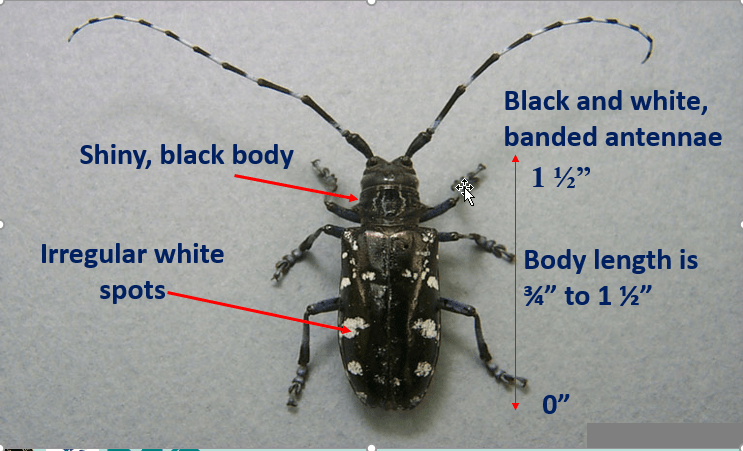The web Browser you are currently using is unsupported, and some features of this site may not work as intended. Please update to a modern browser such as Chrome, Firefox or Edge to experience all features Michigan.gov has to offer.
Heading outdoors? Take 10 to check trees for invasive Asian long-horned beetle
August 21, 2023
Whether you spend time walking, hiking or exploring neighborhood parks, you can help protect Michigan’s trees by spending a little of your outdoors time checking for signs of the Asian longhorned beetle. The U.S. Department of Agriculture has declared August as “Tree Check Month.” Looking for the beetle and the damage it causes is one way you can protect trees and help the USDA’s efforts to eliminate this beetle from the United States.

The Asian longhorned beetle is a large, shiny black beetle with irregular white spots and black and white banded antennae. Courtesy of USDA APHIS PPQ.
The Michigan departments of Agriculture and Rural Development; Environment, Great Lakes, and Energy; and Natural Resources are joining the USDA in asking people to take just 10 minutes this month to check trees in yards, parks and forests for the beetle or any signs of damage.
The Asian longhorned beetle, or ALB for short, is a non-native wood-boring beetle considered invasive in North America because it attacks 12 types of hardwood trees, including maples, elms, horse chestnuts, birches and willows. There are no predators or diseases in North America to keep ALB populations in check. In its larval stage, the insect feeds inside tree trunks and branches during the colder months. The beetle creates tunnels as it feeds, and then it chews its way out as an adult in the warmer months.
Infested trees do not recover and eventually die. They also can become safety hazards since branches can drop and trees can fall, especially during storms.
You can help
Although this invasive beetle has not yet been discovered in Michigan, it is crucial to look for any potential signs of its presence . Discovering early signs of infestation can prevent widespread damage to the state’s forest resources, urban landscapes and maple syrup production.
“You can help us protect more trees and eliminate the beetle from the United States. If you take a walk, take a look,” said Josie Ryan, USDA Animal and Plant Health Inspection Service’s national operations manager for the ALB Eradication Program. “The sooner we spot the beetle, the sooner we can help stop its spread
It is possible to eradicate ALB. To date, the program has successfully eradicated the beetle from 10 locations spanning five states.
Look for signs
Whenever you are outdoors, take time to look at the trees around you for signs of the Asian longhorned beetle, including:
Round exit holes about the diameter of a pencil found in tree trunks and branches.
Shallow oval or round scars in the bark, where the adult beetle chewed an egg site.
Material that looks like wood shavings lying on the ground around the tree or in the branches.
Dead branches or limbs falling from an otherwise healthy-looking tree.
Look for the beetle
Adult Asian longhorned beetles are distinctively large, ranging from 3/4 to 1 1/2 inches in length, not including their long antennae. The beetles are shiny black, with random white blotches or spots, and their antennae have alternating black and white segments. They have six legs that can be black or partly blue, with blue coloration sometimes extending to their feet.
Be aware of look-alikes
Several beetles and bugs native to Michigan often are mistaken for the Asian longhorned beetle, but there are differences to be aware of:
The white-spotted pine sawyer has a distinctive white spot below the base of its head – between its wings – and is brownish in color.
The brown prionid is a common native longhorned beetle distinguished by its overall brown color and lack of patterns on its wings or antennae.
The cottonwood borer is about the same size as the Asian longhorned beetle and is also black and white, but has a pattern of single, broad black stripes down each wing, and its antennae are all dark.
The northeastern pine sawyer reaches up to 2 inches in length, has very long antennae and is gray in color.
The eastern eyed click beetle has distinctive eye circles on the back of its head. It rolls over when threatened, then clicks and makes a flipping movement to get back on its feet.
Anyone observing an Asian longhorned beetle, or a tree appearing damaged by it, is asked to report it. If possible, capture the beetle in a jar, take photos, record the location and report it as soon as possible at 800-292-3939 or MDA-info@Michigan.gov.
More information can be found at Michigan.gov/ALB.
Michigan's Invasive Species Program is cooperatively implemented by the Department of Environment, Great Lakes, and Energy, the Department of Natural Resources, and the Department of Agriculture and Rural Development.